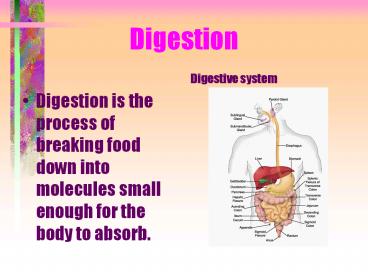Digestion - PowerPoint PPT Presentation
1 / 14
Title:
Digestion
Description:
Digestion of Lipids (fats) Absorption Is the process by which nutrient molecules pass through the wall your digestive tract and into the circulatory system. – PowerPoint PPT presentation
Number of Views:271
Avg rating:5.0/5.0
Title: Digestion
1
Digestion
- Digestive system
- Digestion is the process of breaking food down
into molecules small enough for the body to
absorb.
2
Types of Digestion
- Mechanical Digestion
- The physical breakdown of food by teeth in the
mouth, and muscles in the stomach. - Chemical Digestion
- The breakdown of fats, proteins, and complex
carbs into smaller units by enzymes.
3
The Mouth
- Mechanical digestion begins
4
Chemical Digestion within the Mouth (cont.)
- The salivary glands produce Amylase.
- Starch is digested into its monomer glucose.
5
Esophagus
- Peristalsis
- A muscular tube that connects the mouth to the
stomach. - Peristalsis Involuntary waves of muscle
contractions that push food toward the stomach. - Mucus is a thick slippery substance produced by
the body. It helps make food easier to swallow.
6
The Stomach
- Digestive juice contains the enzyme PEPSIN.
- Pepsin chemically digests the proteins in your
food, breaking them down into amino acids. - Digestive juice also contains hydrochloric acid.
This acid helps break down food and kills many of
the bacteria that enters your body. - The stomach also produces mucus, which coats and
protects the lining of your stomach.
7
The Stomach
- Most mechanical digestion takes place in the
stomach. Three layers of muscles mixes food with
digestive juices in a churning motion. - As you eat your stomach will expand between 1-2
liters to hold the food you eat.
8
The Stomach continued
- Note ( If over time to much acid continually
builds up in the stomach a ulcer may occur.)
9
The Small Intestine
- The small intestine is about 35 - 40 feet long.
- Almost all chemical digestion and absorption of
nutrients take place in the small intestine. - The small intestine contains millions of tiny
finger shaped structures called villi.
10
Digestion of Lipids (fats)
11
Absorption
- Is the process by which nutrient molecules pass
through the wall your digestive tract and into
the circulatory system.
12
The Liver
- The largest and heaviest organ inside the body.
- The liver produces bile, a substance that breaks
up fat molecules. - Bile flows from the liver to the gallbladder,
after you eat the gallbladder passes bile into
the small intestine.
13
The Pancreas
- The pancreas is a triangular organ that lies
below the small intestine. - It produces enzymes that help break down
starches, proteins and Fats.
14
The Large Intestine
- The last section of the digestive system.
- All the remaining water is absorbed into the
bloodstream. - The remaining material is readied for
elimination. - The large intestine ends in a short tube called
the rectum. - The material is compressed into solid form.
- The waste material is eliminated from the body
through the anus.































